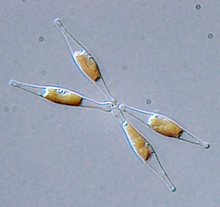| Phaeodactylum tricornutum | |
|---|---|

| |
| Scientific classification | |
| Domain: | Eukaryota |
| Clade: | Diaphoretickes |
| Clade: | SAR |
| Clade: | Stramenopiles |
| Phylum: | Gyrista |
| Subphylum: | Ochrophytina |
| Class: | Bacillariophyceae |
| Order: | Naviculales |
| Family: | Phaeodactylaceae |
| Genus: | Phaeodactylum |
| Species: | P. tricornutum
|
| Binomial name | |
| Phaeodactylum tricornutum Bohlin, 1897
| |
Phaeodactylum tricornutum is a diatom. Unlike other diatoms, P. tricornutum can exist in different morphotypes (fusiform, triradiate, and oval) and changes in cell shape can be stimulated by environmental conditions.[1] This feature can be used to explore the molecular basis of cell shape control and morphogenesis. Unlike most diatoms, P. tricornutum can grow in the absence of silicon and can survive without making silicified frustules.[2] This provides opportunities for experimental exploration of silicon-based nanofabrication in diatoms.
Another peculiarity is that during asexual reproduction the frustules do not appear to become smaller. This allows continuous culture without need for sexual reproduction. It is not known if P. tricornutum can reproduce sexually. To date no substantial evidence has been found to support sexual reproduction in a laboratory or other setting. Although P. tricornutum can be considered to be an atypical pennate diatom, it is one of the main diatom model species. A transformation protocol has been established and RNAi vectors are available.[3][4] This makes molecular genetic studies much easier.
- ^ De Martino, A; Meichenin, A; Shi, J; Pan, KH; Bowler, C (2007). "Genetic and phenotypic characterization of Phaeodactylum tricornutum (Bacillariophyceae) accessions". Journal of Phycology. 43 (5): 992–1009. doi:10.1111/j.1529-8817.2007.00384.x. S2CID 85769550.
- ^ Chuang, Chia-Ying; Santschi, Peter H.; Jiang, Yuelu; Ho, Yi-Fang; Quigg, Antonietta; Guo, Laodong; Ayranov, Marin; Schumann, Dorothea (2014-06-20). "Important role of biomolecules from diatoms in the scavenging of particle-reactive radionuclides of thorium, protactinium, lead, polonium, and beryllium in the ocean: A case study with Phaeodactylum tricornutum". Limnology and Oceanography. 59 (4): 1256–1266. Bibcode:2014LimOc..59.1256C. doi:10.4319/lo.2014.59.4.1256. ISSN 0024-3590. S2CID 98646215.
- ^ Apt, K. E.; et al. (1996). "Molecular and General Genetics Stable nuclear transformation of the diatom Phaeodactylum tricornutum". Molecular and General Genetics. 252 (5): 572–579. doi:10.1007/BF02172403. PMID 8914518. S2CID 29664801.
- ^ De Riso, V; Raniello, R.; Maumus, F.; Rogato, A.; Bowler, C.; Falciatore, A. (2009). "Gene silencing in the marine diatom Phaeodactylum tricornutum". Nucleic Acids Research. 37 (14): e96. doi:10.1093/nar/gkp448. PMC 2724275. PMID 19487243.